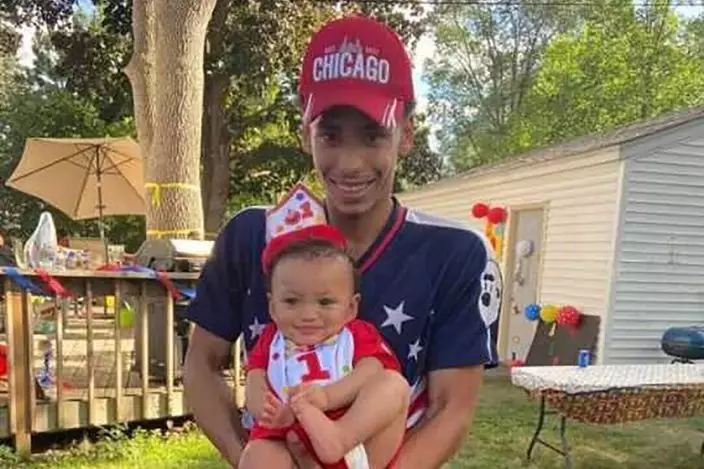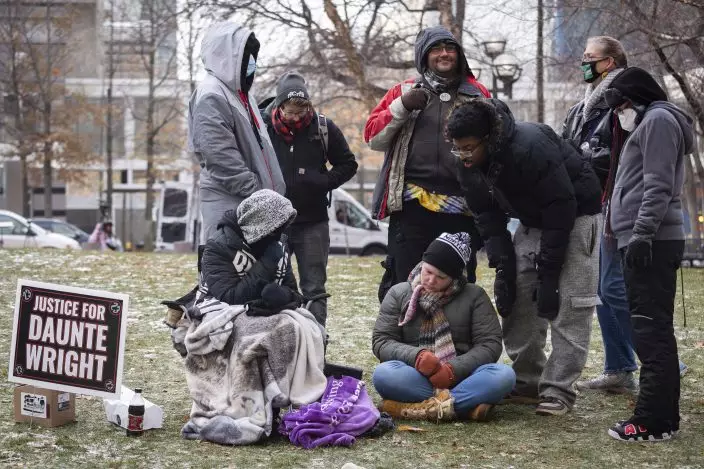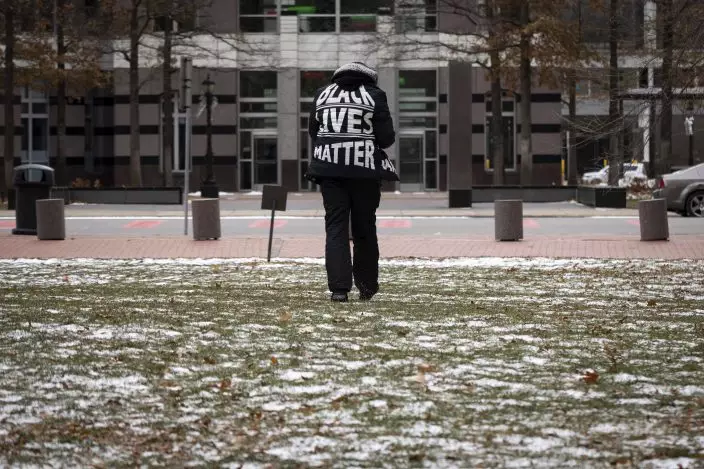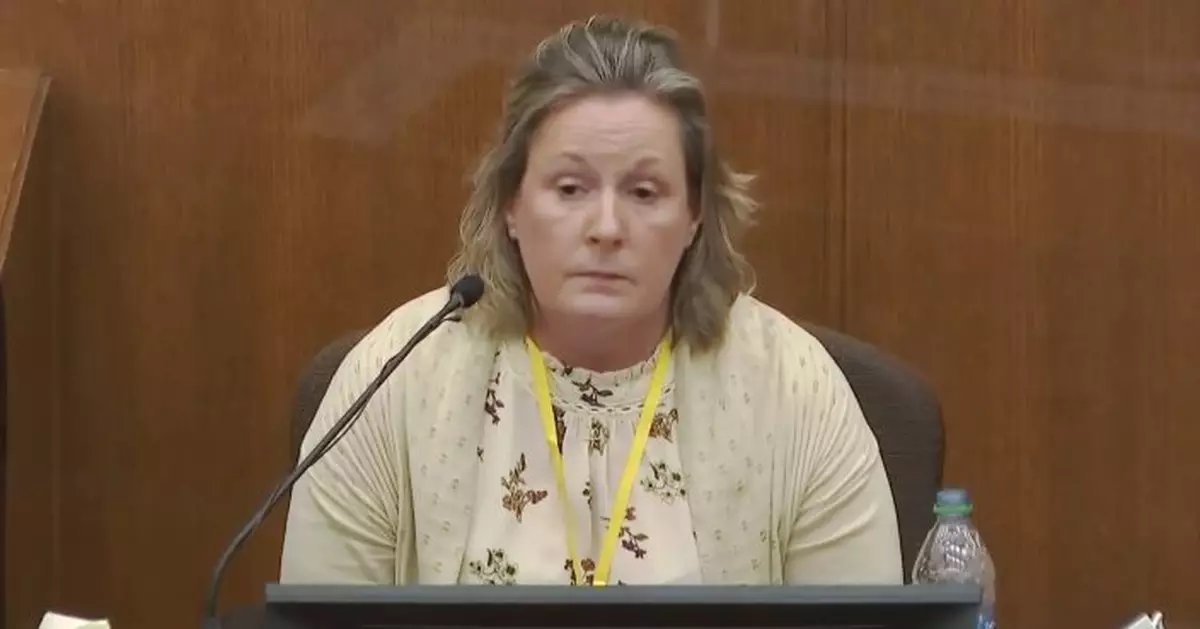A jury will resume deliberations Tuesday in the trial of a suburban Minneapolis police officer who says she meant to use her Taser instead of her gun when she shot and killed Black motorist Daunte Wright.
The jury met for about a five hours Monday following closing arguments in which prosecutors accused Kim Potter of a “blunder of epic proportions” in Wright's death in an April 11 traffic stop — but said a mistake was no defense.
Potter's attorneys countered that Wright, who was attempting to get away from officers as they sought to handcuff him for an outstanding warrant on a weapons charge, “caused the whole incident.”

FILE - This photo provided by Ben Crump Law, PLLC. shows Daunte Wright and his son, Daunte Jr., at his first birthday party. Wright, 20, was fatally shot by Kim Potter, a white suburban Minneapolis police officer, during a traffic stop on Sunday, April 11, 2021. Potter is currently on trial for manslaughter in Wright's death. (Ben Crump Law, PLLC. via AP)
Potter, who is white, is charged with first- and second-degree manslaughter. If convicted of the most serious charge, Potter, 49, would face a sentence of about seven years under state guidelines, though prosecutors have said they will seek more.
The mostly white jury got the case after about a week and a half of testimony about an arrest that went awry, setting off angry protests in Brooklyn Center just as nearby Minneapolis was on edge over Derek Chauvin's trial in George Floyd's death. Potter resigned two days after Wright's death.
Prosecutor Erin Eldridge called Wright’s death “entirely preventable. Totally avoidable.” She urged the jury not to excuse it as a mistake: "Accidents can still be crimes if they occur as a result of reckless or culpable negligence."

Activists watch the trial of former Brooklyn Center police Officer Kim Potter, Friday Dec. 17, 2021, outside the Hennepin County Courthouse in Minneapolis. Potter, who is white, is charged with first- and second-degree manslaughter in the shooting of Daunte Wright, a Black motorist, in the suburb of Brooklyn Center. Potter has said she meant to use her Taser – but grabbed her handgun instead – after Wright tried to drive away as officers were trying to arrest him. (AP PhotoChristian Monterrosa)
“She drew a deadly weapon,” Eldridge said. “She aimed it. She pointed it at Daunte Wright’s chest, and she fired.”
Potter's attorney Earl Gray argued that Wright was to blame for trying to flee from police. Potter mistakenly grabbed her gun instead of her Taser because the traffic stop “was chaos,” he said.
“Daunte Wright caused his own death, unfortunately,” he said. He also argued that shooting Wright wasn't a crime.

A demonstrator wears a Black Lives Matter jacket outside of the Hennepin County Courthouse outside of the Hennepin County Courthouse during the trial of former Brooklyn Center police Officer Kim Potter, Friday Dec. 17, 2021, in Minneapolis. Potter, who is white, is charged with first- and second-degree manslaughter in the shooting of Daunte Wright, a Black motorist, in the suburb of Brooklyn Center. Potter has said she meant to use her Taser – but grabbed her handgun instead – after Wright tried to drive away as officers were trying to arrest him. (AP PhotoChristian Monterrosa)
“In the walk of life, nobody’s perfect. Everybody makes mistakes," Gray said. “My gosh, a mistake is not a crime. It just isn’t in our freedom-loving country."
Potter testified Friday that she “didn’t want to hurt anybody” and that she was “sorry it happened."
Eldridge said the case wasn’t about whether Potter was sorry.
“Of course she feels bad about what she did. … But that has no place in your deliberations,” she said.
Playing Potter’s body camera video frame by frame, Eldridge sought to raise doubts about Potter’s testimony that she fired after seeing “fear” on the face of another officer, then-Sgt. Mychal Johnson, who was leaning into the car’s passenger-side door and trying to handcuff Wright.
The defense has argued that Johnson was at risk of being dragged and that Potter would have been justified in using deadly force. But Eldridge pointed out that for much of the interaction Potter was behind a third officer, whom she was training, and that Johnson didn't come into her camera's view until after the shot was fired — and then it showed the top of his head as he backed away.
“Sgt. Johnson was clearly not afraid of being dragged,” Eldridge said. “He never said he was scared. He didn’t say it then, and he didn’t testify to it in court.”
Eldridge also noted that Potter put other people at risk when she fired her gun, highlighting that the third officer was so close to the shooting that a cartridge casing bounced off his face.
“Members of the jury, safe handling of a firearm does not include firing it into a car with four people directly in harm’s way,” she said.
Gray started his closing argument by attacking Eldridge's summation, highlighting how she had played slowed-down depictions of events that Potter saw in real time.
“Playing the video not at the right speed where it showed chaos, playing it as slow as possible … that’s the rabbit hole of misdirection,” Gray said. He also noted that Potter's body camera was mounted on her chest and gave a slightly different perspective than her own vision.
Judge Regina Chu told jurors that intent is not part of the charges and that the state doesn’t have to prove she tried to kill Wright.
The judge said for first-degree manslaughter, prosecutors must prove that Potter caused Wright’s death while committing the crime of reckless handling of a firearm. This means they must prove that she committed a conscious or intentional act while handling or using a firearm that creates a substantial or unjustifiable risk that she was aware of and disregarded, and that she endangered safety.
For second-degree manslaughter, prosecutors must prove she acted with culpable negligence, meaning she consciously took a chance of causing death or great bodily harm.
Find the AP’s full coverage of the Daunte Wright case: https://apnews.com/hub/death-of-daunte-wright


